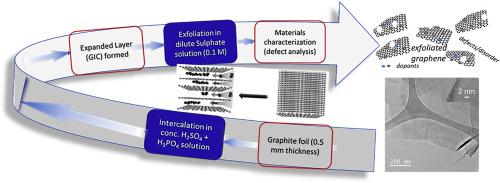Our official English website, www.x-mol.net, welcomes your
feedback! (Note: you will need to create a separate account there.)
Mixed-acid intercalation for synthesis of a high conductivity electrochemically exfoliated graphene
Carbon ( IF 10.5 ) Pub Date : 2021-01-01 , DOI: 10.1016/j.carbon.2020.08.066 Damilola Momodu , Moshawe J. Madito , Ashutosh Singh , Farbod Sharif , Kunal Karan , Milana Trifkovic , Steven Bryant , Edward P.L. Roberts
Carbon ( IF 10.5 ) Pub Date : 2021-01-01 , DOI: 10.1016/j.carbon.2020.08.066 Damilola Momodu , Moshawe J. Madito , Ashutosh Singh , Farbod Sharif , Kunal Karan , Milana Trifkovic , Steven Bryant , Edward P.L. Roberts

|
Abstract Precise control of electrochemical intercalation and exfoliation conditions provides a method for tuning graphene properties. A systematic evaluation of the defects induced in graphene for varying intercalation times and intercalant composition is done using a sulphuric and phosphoric acid mixtures. Intercalation was performed in a concentrated mixture of sulphuric and phosphoric acid, followed by anodic exfoliation in aqueous ammonium sulphate solution. Multi-atom-doped graphene with primarily “boundary-type” defects is obtained, and the ratio of the defect-activated Raman modes showed a unique characteristics at 1600 s intercalation, irrespective of the intercalant composition. Careful selection of intercalation time is required to control the graphene defects. Phosphorus and nitrogen-doping increased with phosphoric acid content, influencing graphene properties. Interestingly, extending intercalation times beyond 1600 s deteriorated the electrical conductivity but enhanced the thermal stability with higher phosphoric acid content. We attribute this to loss of the sp2 graphitic structure at higher intercalation times which dominates over contributions from the dopants. The highest electrical conductivity of ∼14,000 S m-1 was two orders of magnitude higher than graphene obtained with pure sulphuric-acid intercalation. By adding phosphoric acid into the intercalant, the energy consumption and exfoliation time was reduced by 34% and by a factor of 3 respectively.
中文翻译:

用于合成高电导率电化学剥离石墨烯的混合酸插层
摘要 电化学嵌入和剥离条件的精确控制提供了一种调节石墨烯性能的方法。使用硫酸和磷酸混合物对不同嵌入时间和嵌入剂组成的石墨烯中引起的缺陷进行系统评估。在硫酸和磷酸的浓混合物中进行插层,然后在硫酸铵水溶液中进行阳极剥离。获得了主要具有“边界型”缺陷的多原子掺杂石墨烯,并且无论嵌入剂成分如何,缺陷激活拉曼模式的比率在 1600 s 嵌入时都显示出独特的特性。需要仔细选择嵌入时间来控制石墨烯缺陷。磷和氮掺杂随着磷酸含量的增加而增加,影响石墨烯的性能。有趣的是,将嵌入时间延长到 1600 秒以上会降低电导率,但会提高磷酸含量的热稳定性。我们将此归因于 sp2 石墨结构在更高的嵌入时间中的损失,这在掺杂剂的贡献中占主导地位。约 14,000 S m-1 的最高电导率比通过纯硫酸插层获得的石墨烯高两个数量级。通过在插层剂中加入磷酸,能耗和剥离时间分别降低了 34% 和 3 倍。我们将此归因于 sp2 石墨结构在更高的嵌入时间中的损失,这在掺杂剂的贡献中占主导地位。约 14,000 S m-1 的最高电导率比通过纯硫酸插层获得的石墨烯高两个数量级。通过在插层剂中加入磷酸,能耗和剥离时间分别降低了 34% 和 3 倍。我们将此归因于 sp2 石墨结构在更高的嵌入时间中的损失,这在掺杂剂的贡献中占主导地位。约 14,000 S m-1 的最高电导率比通过纯硫酸插层获得的石墨烯高两个数量级。通过在插层剂中加入磷酸,能耗和剥离时间分别降低了 34% 和 3 倍。
更新日期:2021-01-01
中文翻译:

用于合成高电导率电化学剥离石墨烯的混合酸插层
摘要 电化学嵌入和剥离条件的精确控制提供了一种调节石墨烯性能的方法。使用硫酸和磷酸混合物对不同嵌入时间和嵌入剂组成的石墨烯中引起的缺陷进行系统评估。在硫酸和磷酸的浓混合物中进行插层,然后在硫酸铵水溶液中进行阳极剥离。获得了主要具有“边界型”缺陷的多原子掺杂石墨烯,并且无论嵌入剂成分如何,缺陷激活拉曼模式的比率在 1600 s 嵌入时都显示出独特的特性。需要仔细选择嵌入时间来控制石墨烯缺陷。磷和氮掺杂随着磷酸含量的增加而增加,影响石墨烯的性能。有趣的是,将嵌入时间延长到 1600 秒以上会降低电导率,但会提高磷酸含量的热稳定性。我们将此归因于 sp2 石墨结构在更高的嵌入时间中的损失,这在掺杂剂的贡献中占主导地位。约 14,000 S m-1 的最高电导率比通过纯硫酸插层获得的石墨烯高两个数量级。通过在插层剂中加入磷酸,能耗和剥离时间分别降低了 34% 和 3 倍。我们将此归因于 sp2 石墨结构在更高的嵌入时间中的损失,这在掺杂剂的贡献中占主导地位。约 14,000 S m-1 的最高电导率比通过纯硫酸插层获得的石墨烯高两个数量级。通过在插层剂中加入磷酸,能耗和剥离时间分别降低了 34% 和 3 倍。我们将此归因于 sp2 石墨结构在更高的嵌入时间中的损失,这在掺杂剂的贡献中占主导地位。约 14,000 S m-1 的最高电导率比通过纯硫酸插层获得的石墨烯高两个数量级。通过在插层剂中加入磷酸,能耗和剥离时间分别降低了 34% 和 3 倍。









































 京公网安备 11010802027423号
京公网安备 11010802027423号